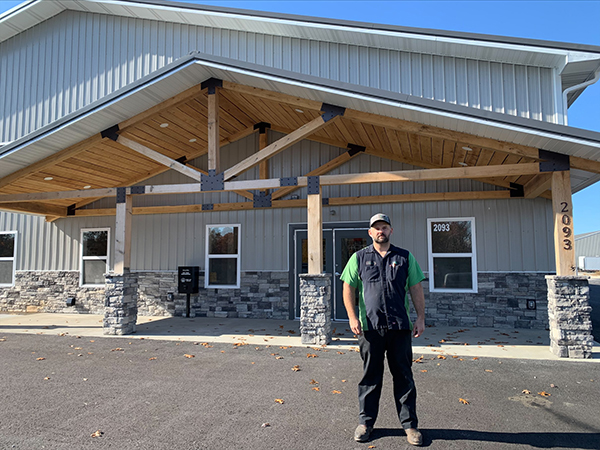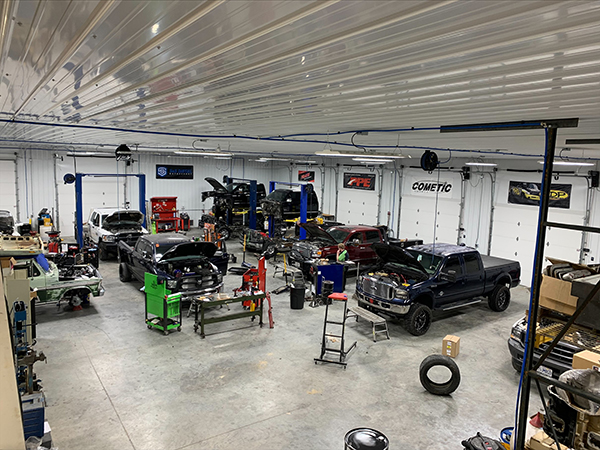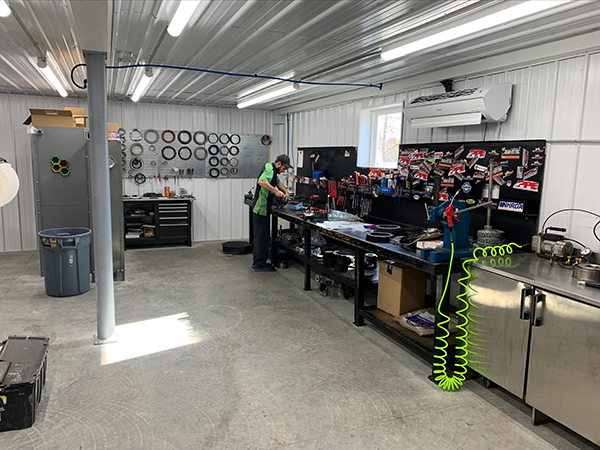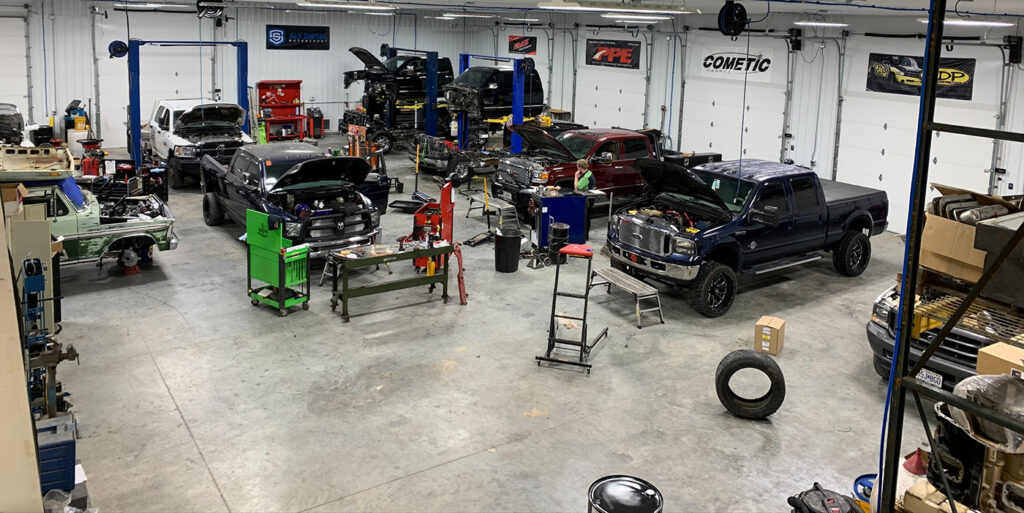Stop me if this sounds familiar… you’ve been out of shop space since day one, you have nowhere left to put parts and components for customer builds, engines are sprawled everywhere, you have little to no useable office space remaining, you can’t bring in new equipment due to lack of space, and you’re generally just ready to move on from your current shop. You’re not alone! Many engine builders we hear from would be ecstatic to move into a new shop or build one from scratch that better suited their needs.
We understand that this dream isn’t always a reality, but recently we’ve noticed that many shop owners are moving into new digs or building better shops from scratch in order to take that next step of growth. If you’re seriously considering a new shop space, there are a number of things to ensure you consider before jumping into this massive undertaking. We recently caught up with Jeff McCord of LinCo Diesel Performance in Troy, MO after he successfully went from 6,600 sq.-ft. of space into roughly 25,000 sq.-ft. to find out what he learned from the experience, which has put his shop in position to better serve customers and continue to grow.
Jeff has owned LinCo Diesel Performance since 2010, however, the shop used to be known as LinCo Truck and Tractor Repair in those early days. In 2013, Jeff moved the shop into a 6,600 sq.-ft. facility thinking his shop would be there for a long time, but he soon found they were out of space before the shop even had a chance to spread its wings.

“Back in 2013, we were doing heavy equipment, heavy truck and light-duty diesel repair,” McCord says. “When we moved into that building, it was still a pretty big upgrade from the original building I started in. At one point, we had as many as 13 employees working on everything up through and including D8 Cat dozers. We’d have lifts and dozers all over the place, semis, and then we’d have a 6.7L in the corner getting head studs. We cranked out a lot of work there, but by 2016 we had outgrown the 6,600 sq.-ft. building.”
According to Jeff, the diesel shop desperately lacked office space, parts storage areas and space for its growing transmission work to get accomplished, a horrible parking lot situation, and numerous other shortcomings.
“Office space was definitely lacking,” he says. “There was no place to showcase any parts without things being cluttered up. It was the same with parts storage. There was stuff everywhere and we just had no room. The other thing was we started building transmissions in-house in 2016, so we built a small assembly room at the time that was 10’x25’ and climate controlled. We thought we were hot when we built that, but we outgrew that quickly with the amount of transmissions we do.”
Jeff soon had plans in place to find property that would fit his shop’s future goals. In conjunction with those plans, Jeff was also pursuing the purchase of LDP Machine, a nearby engine machine shop with owners looking to sell the business.
“Around four years ago, I started looking for property with the intentions of building a new shop,” McCord says. “It was probably 2017 that I found this property. I wanted enough property that we could build the building that we knew we needed and still have plenty of room to expand. I found six and a half acres right on the highway just outside of town. I bought that in ‘17. We continued flipping trucks and making moves and slowly got the property paid off.

“The way it all went down was I bought the six and a half acres of property and it was almost paid off. The two owners of the machine shop came to me and said that they were wanting to get out of the smaller building they were in and have one last hoorah to try to grow the business. Since they knew I wanted to buy them out, they asked me to sell them an acre of the new property and they’d build a building to move up there. Then, when I moved up there, we’d be right there by each other and when I bought them out, it would be easy.”
Jeff sold them 1.1 acres and LDP Machine built an 8,600 sq.-ft. shop space. Not even a year later, LDP Machine approached Jeff about buying them out.
“That definitely threw a monkey wrench in the original plans, but it worked out great,” he admits. “It was the best thing that ever could have happened in the long run because things would have been done differently otherwise. We bought out the machine shop in September 2020, so a lot of my focus was on the transition with that, but also on building a new facility for LinCo Diesel Performance.”
When it came time for Jeff to break ground on LinCo’s new shop, he was now able to build it with LDP Machine in mind as well, and how the two shops would function together.
“When you’re in a building that’s too small and inefficient, you’ve got plenty of time to think about ways that you would improve it,” McCord says. “I had several years to know where we were lacking on space and what we needed to do to improve it as far as the way the bays were oriented and getting trucks blocked in and having to drag trucks out – stuff like that. Every day you’re thinking about what you wish you had and how you would do it differently if you could.

“In the new building, we went from basically one office to 3,500 sq.-ft. of office space now. We essentially have 10 times the amount of office space we previously had, and on top of that, we’ve got a huge, nice showroom that’s 30’x20’ with 17’ walls and has a 10’x10’ glass overhead door, so you can get a truck in there. People walk into that now instead of walking into a tiny office, tripping over boxes. Now, they walk into nice, big, glass double doors and a huge area, and off of that you’ve got parts and service. That was a big thing for me was the showroom and the office area.
“For the parts warehouse space, we’ve got 1,600 sq.-ft. for storage, and down in the shop, we’ve got a whole bay – 50-ft. deep – of pallet shelving for shipping and receiving and for all of our cores and everything. Next to that is the transmission room, which is 20’x30’ and it’s got its own separate climate control from the shop. Then, we’ve got a 20’x20’ tear down room with all the cleaning equipment and stainless benches. That has its own separate climate control as well. The shop itself has a 20-ton air conditioning system just for the shop. There’s 34-tons of air conditioning for the whole building.”
Since Jeff took his time to plan everything out exactly how he wanted, he was able to layout everything to be as efficient as possible and offer good workflow.
“We have just shy of 15,000 sq.-ft. in the new shop,” he says. “When you combine that with the space for the new machine shop, we’re just under 25,000 sq.-ft. The new shop sits parallel to the machine shop and they are just 60-feet apart, divided by asphalt. That’s nice because you can pull an engine and then drive a forklift across the asphalt right into the machine shop to be torn down and vice versa. When engines are done, they get off the stand and go across the parking lot to the other shop.”
Now that LinCo Diesel Performance has its new space, Jeff has had time to reflect on how it all came together and what others might want to consider in their own shops.
“As far as picking out the location and the size of your building, make sure you have room to expand, because the reason you’re doing this is because you already outgrew what you had or you’re looking to improve,” he points out. “Make sure that whatever you get, you don’t limit yourself. Make sure there’s room to grow in some way, shape or form. Whatever space you think you need, you want to go bigger.

“Before you buy a piece of property, have a grade and excavating contractor look at it with you, so you understand if you need a whole bunch of fill or anything. In my case we did. I feel I still bought it right, but between the machine shop and my building, there was $150,000 of fill and time to build the building pads and grade everything. Definitely make sure that the property is checked out by a grade and excavating contractor to ensure that the size of it and the shape of it suits the needs of, not only the building, but the parking too.”
Overall, McCord told us he has been tickled pink with how the shop has turned out. Fortunately, he said there’s nothing major that he missed.
“There’s little things like we could’ve put that door there or done this or that, but nothing major overall,” he says. “I’m very happy. It was very well thought out with a lot of years to think about it.”
One of the best decisions McCord said he made was to install radiant heat in the floors of the new shop, which help keep the large space at a nice temperature.
“The machine shop has it, so I was sold on it,” he says. “Usually, it’s warmer in the building than the thermostat is set on. It’s extremely efficient, so I would highly advise anybody building a building to do some form of radiant heat in the floor. If you’re going to do it, you need to take the time to lay out where you want your lifts and anything else that’s going to be anchored to the ground and draw it out on a blueprint and keep that. All our lifts were all planned out and thought ahead on. Even things like the pallet shelving were all mapped out, so we could run the tubing accordingly for the heat and anchor those shelves in the floor.”
Today, LinCo Diesel Performance has been operating out of its new shop space for a year, and Jeff knows he was lucky to find such a good piece of property that’ll serve his shop well for many years to come.
“It’s not every day you’re going to come across five-plus acres of commercial property that’s on the highway,” he says. “We were able to build the buildings that we wanted and still have plenty of room for expansion.” EB














